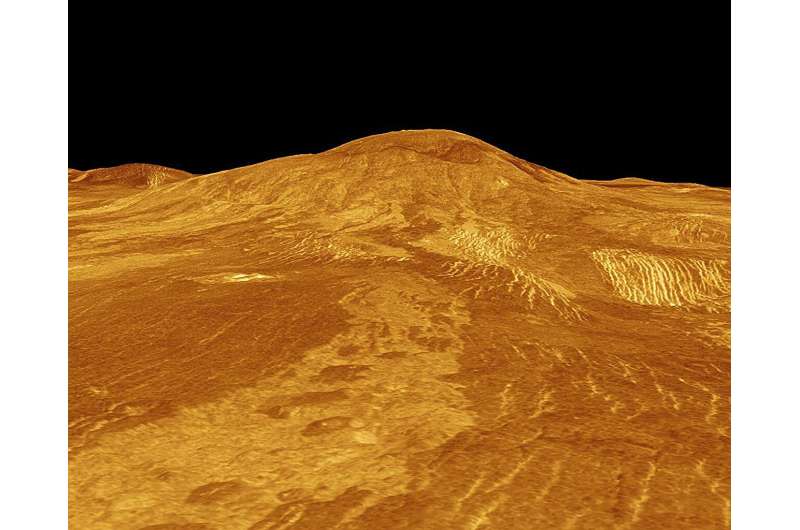May 27, 2024 feature
This article has been reviewed according to Science X's editorial process and policies. Editors have highlighted the following attributes while ensuring the content's credibility:
fact-checked
peer-reviewed publication
trusted source
proofread
Recent and extensive volcanism discovered on Venus

A new analysis of data collected on Venus more than 30 years ago suggests the planet may currently be volcanically active.
A research group from Italy led by David Sulcanese of the Università d'Annunzio in Pescara, Italy, has used data from a radar mapping of Venus's surface taken in the early 1990s to search for volcanic lava flow, finding it in two regions.
The discovery suggests that volcanic activity may be currently active and more widespread than was previously thought, supporting previous indirect evidence that there is volcanic activity on Venus.
The work is published in the journal Nature Astronomy.
Venus is sometimes called "Earth's twin sister." Though only slightly smaller than Earth, its CO2-dominated atmosphere has a massive greenhouse effect that bakes its surface at about 465°C (870°F).
Although billions of years ago, Venus's surface and atmosphere was likely much like Earth today, with liquid water present, the ever-brightening sun and volcanic activity raised temperatures enough to evaporate all water from the planet, leading to a runaway greenhouse effect.
Today, Venus seems desiccated, broiling hot and seemingly dead, surrounded by dense clouds of sulfuric acid.
Between 1990 and 1992, the Magellan spacecraft, launched from NASA's space shuttle in 1989, orbited Venus with an array of scientific instruments, dropping as low as 295 km above the planet's surface.
Comparing Magellan's first cycle of radar scans taken January–September 1992 [Earth time] to the third cycle taken from Sept. 1990 to May 1991, both of which had a mean resolution of 150 meters, the researchers performed a number of adjustments to make the comparisons useful, such as adjusting backscatter for different viewing angles.
Both these cycles of scans had a left-view angle from the satellite, whereas the second cycle had a right-looking approach.
The first region encompasses lava flow features on the western flank of Sif Mons, a shield volcano at 22° north latitude on Venus that is a low-profile volcano that lies quite shallow on the ground, like the profile of a flat shield. The second region was the western part of Niobe Planitia at a similar latitude, 21° north, characterized by a flat terrain, many shield volcanoes and shield-related volcanic material.
After investigating a host of other possibilities for their observations, the group writes that their "best interpretation" of the observations is that the surface scattering properties of Venus, such as its roughness and composition, changed from the first cycle of scans to the third cycle, an interval of roughly 16 months. The changed features observed are probably explained, they write, as new lava flows that took place during the Magellan mission.
"Our study covered only about 16% of Venus's surface due to the limitation of comparing images from just the two left-look cycles," said lead author Sulcanese, who works at his university's International Research School of Planetary Sciences. "Therefore, it is likely that more evidence of this nature exists on Venus," he said.
The finding supports previous work that inferred recent volcanic activity on Venus from indirect evidence, such as variations in the sulfuric acid in the atmosphere, changes in a region's thermal emissivity data (which measures the ability to emit electromagnetic radiation, mostly in the infrared), and morphological analysis of volcanic-like surface features.
It was found that Venus may undergo up to 42 volcanic eruptions a year, with an estimated 20 eruptions that last more than 1,000 Earth days. (Venus rotates extremely slowly; a day on Venus is actually longer than its year. If you were born on Venus, everyday would be your birthday.) This present work implies there may be as many as 120 discrete eruptions per Earth year.
Estimates of the volcanic flow rates for each of the two regions were derived by assuming the thickness of the flows in the range 3 m to 20 m, the known terrestrial values, and using the observed flow areas of the regions.
Sif Mons has a maximum flow rate of 25 km3/Earth-year, and Niobe Planitia 38 km3/Earth year. The sum of the maximum flow rates means volcanic activity on Venus could be the same order of magnitude as Earth's, making it more volcanically active than previously thought.
"Future missions like VERITAS and EnVision will revisit Venus's surface," said Sulcanese, "allowing us to compare their data with the Magellan mission's images. This will enable us to identify surface changes over a period of more than 40 years."
More information: Davide Sulcanese, Evidence of ongoing volcanic activity on Venus revealed by Magellan radar, Nature Astronomy (2024). DOI: 10.1038/s41550-024-02272-1. www.nature.com/articles/s41550-024-02272-1
Journal information: Nature Astronomy
© 2024 Science X Network




















